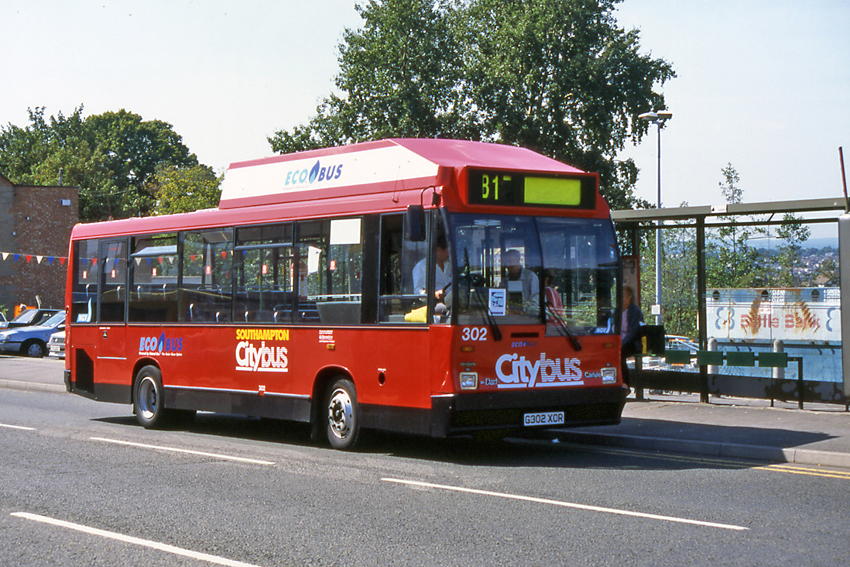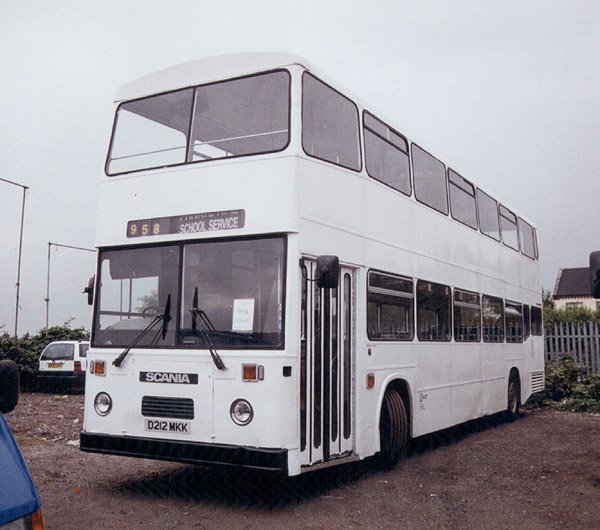|
East Lancs 1984-style Double-deck Body
The East Lancs 1984-style double-deck body is a type of double-decker bus body with a step-entrance, built on several different chassis by East Lancashire Coachbuilders in England. Chassis Several different chassis types were fitted with this style of bodywork. These include: * Dennis Dominator * Volvo B10M * Leyland Olympian * Scania N112 and N113 * Volvo B58 (rebody) Description This distinctive style of bodywork has a downward-sloping front window bay on the upper deck, with both top and bottom edges angled downwards. The side windows are square-cornered. A large double-curvature upper deck windscreen (either single-piece or two-piece) is one of the most distinctive features. Originally a tall, wrap-around lower deck windscreen was fitted, but some batches were fitted with a double-curvature windscreen, with either a straight or an arched top. A batch of Dennis Dominators built for Southampton Citybus have bodywork which is mostly to this style, including the downsw ... [...More Info...] [...Related Items...] OR: [Wikipedia] [Google] [Baidu] |
Dennis Dominator
The Dennis Dominator was Dennis's first rear-engined double-decker bus chassis, it was launched in 1977. History Dennis had been absent from the bus manufacturing market since the last Lolines were produced in 1967. The Dominator was described as bespoke, with numerous options. To some extent it was considered a successor to the Daimler/Leyland Fleetline. The Dominator was different from the Fleetline in that the radiator was located at the front instead of the offside of the engine compartment. It was intended to be sold mainly with the Gardner 6LXB engine coupled up to a Voith DIWA transmission and a drop-centre rear axle, but hub-reduction rear axle and other engine options including the Rolls-Royce Eagle, the Cummins L10, the turbocharged Gardner 6LXCT and DAF engines were also available. United Kingdom The largest British customer of the Dennis Dominator was South Yorkshire PTE, with a total of 318 buses being delivered to the company. These included one tro ... [...More Info...] [...Related Items...] OR: [Wikipedia] [Google] [Baidu] |
Southampton Citybus
Southampton Citybus was a bus operator which operated local services throughout the English city of Southampton. It was formed in 1898 as Southampton Corporation Transport. In 1986, as a result of deregulation an 'arms-length' limited company was formed in the name of ''Southampton Citybus'' and the coat of arms of the City of Southampton was removed, and replaced with the new branding. The company was owned by the town council until 1954, and the city council until 1993. It was then bought by its employees, in 1997 it was purchased by FirstGroup and is now part of First Hampshire & Dorset. History Southampton Citybus was formed in 1898 as Southampton Corporation Transport when the town council took over the Southampton Tramways Company. The company initially operated a fleet of horse-drawn trams and buses, replacing them with electric trams in 1901. A motorbus service was launched in 1901 but proved unsuccessful, and was withdrawn until 1919, when it was reintroduced. The tr ... [...More Info...] [...Related Items...] OR: [Wikipedia] [Google] [Baidu] |
Double-decker Buses
A double-decker bus or double-deck bus is a bus that has two storeys or decks. They are used for mass transport in the United Kingdom, the United States, New Zealand, Europe, Asia and also in cities such as Sydney; the best-known example is the red London bus, namely the AEC Routemaster. Early double-deckers put the driver in a separate cab. Passenger access was via an open platform at the rear and a bus conductor collected fares. Modern double-deckers have a main entrance door at the front and the driver takes fares, thus halving the number of workers aboard, but slowing the boarding process. The rear open platform, popular with passengers, was abandoned for safety reasons, as there was a risk of passengers falling when running and jumping onto the bus. Double-deckers are primarily for commuter transport, but open-top models are used as sight-seeing buses for tourists. William Gladstone, speaking of London's double-deck horse-drawn omnibuses, once observed that "...the best w ... [...More Info...] [...Related Items...] OR: [Wikipedia] [Google] [Baidu] |
List Of Buses ...
Year refers to the first year introduced. A range of years is the period the bus was manufactured. # A B C D E F G H I J K L M N O P Q R S T U V W X Y Z Š See also * Bus spotting * Coach (used for long-distance travel) * Dollar van * List of fictional buses * List of Leyland buses * List of AEC buses * Multi-axle bus * Trackless train * Tram * Single decker buses References {{South American bus builders 01 * * Bus A bus (contracted from omnibus, with variants multibus, motorbus, autobus, etc.) is a road vehicle that carries significantly more passengers than an average car or van. It is most commonly used in public transport, but is also in use for cha ... [...More Info...] [...Related Items...] OR: [Wikipedia] [Google] [Baidu] |
Arriva Midlands
Arriva Midlands is a bus operator providing services in the East Midlands and West Midlands areas of England. It is a subsidiary of Arriva UK Bus. Arriva Midlands North Operations In September 1981 Midland Red North was formed with 230 buses operating from six depots in Shropshire, Staffordshire and the West Midlands as part of the breakup of the Midland Red bus company.Midland Red Depots MidlandRed.net In May 1983 the depot was closed. In January 1988 Midland Red North was sold to the Drawlane Transport Group. In November 1992 it was sold to which in August 1996 was sold to the ... [...More Info...] [...Related Items...] OR: [Wikipedia] [Google] [Baidu] |
North Western Road Car Company (1986)
North Western Road Car CompanyCompanies House extract company no 523376 Arriva North West Limited formerly North Western Road Car Company Limited formerly Mexborough & Swinton Traction Company Limited was a bus operator based in , England. The company operated between 1986 and 1998. History In the lead up to the of the National Bus Company, in 1986 the go ...[...More Info...] [...Related Items...] OR: [Wikipedia] [Google] [Baidu] |
London Country South West
London Country South West (LCSW) was a bus operator in South East England and London. It was formed from the split of London Country Bus Services in 1986 and operated a fleet of around 415 buses from 10 garages, with its headquarters in Reigate. History In the run-up to Bus deregulation in the United Kingdom, deregulation, London Country Bus Services was broken into four smaller companies on 7 September 1986. The South West division contained 415 buses. On 19 February 1988, LCSW was sold to the Drawlane Group. In 1989 the London & Country trading name was adopted, being applied to a new two-tone green and red livery. LCSW entered the London Regional Transport market, winning several contracts using second-hand Leyland Atlanteans from Greater Glasgow, GM Buses and Busways Travel Services, Busways, where deregulation was making the major fleets dispose of large numbers of surplus vehicles. LCSW then purchased new buses, with a batch of Dennis Dominators purchased for London Bu ... [...More Info...] [...Related Items...] OR: [Wikipedia] [Google] [Baidu] |
Coach (bus)
A coach (or coach bus/motorcoach) is a type of bus built for longer-distance service, in contrast to transit buses that are typically used within a single metropolitan region. Often used for touring, intercity, and international bus service, coaches are also used for private charter for various purposes. Coaches are also related and fall under a specific category/type of RVs. Deriving the name from horse-drawn carriages and stagecoaches that carried passengers, luggage, and mail, modern motor coaches are almost always high-floor buses, with separate luggage hold mounted below the passenger compartment. In contrast to transit buses, motor coaches typically feature forward-facing seating, with no provision for standing. Other accommodations may include onboard restrooms, televisions, and overhead luggage space. History Background Horse-drawn chariots and carriages ("coaches") were used by the wealthy and powerful where the roads were of a high enough standard from p ... [...More Info...] [...Related Items...] OR: [Wikipedia] [Google] [Baidu] |
First Leicester
Leicester Citybus,Companies House extract company no 2000072 Leicester Citybus Limited First Leicester, is a bus operator providing services in . own 94% of the company with owning the other 6%. History [...More Info...] [...Related Items...] OR: [Wikipedia] [Google] [Baidu] |
Double-decker Bus
A double-decker bus or double-deck bus is a bus that has two storeys or decks. They are used for mass transport in the United Kingdom, the United States, New Zealand, Europe, Asia and also in cities such as Sydney; the best-known example is the red London bus, namely the AEC Routemaster. Early double-deckers put the driver in a separate cab. Passenger access was via an open platform at the rear and a bus conductor collected fares. Modern double-deckers have a main entrance door at the front and the driver takes fares, thus halving the number of workers aboard, but slowing the boarding process. The rear open platform, popular with passengers, was abandoned for safety reasons, as there was a risk of passengers falling when running and jumping onto the bus. Double-deckers are primarily for commuter transport, but open-top models are used as sight-seeing buses for tourists. William Gladstone, speaking of London's double-deck horse-drawn omnibuses, once observed that "...the best w ... [...More Info...] [...Related Items...] OR: [Wikipedia] [Google] [Baidu] |
East Lancashire Coachbuilders
East Lancashire Coachbuilders Limited was a manufacturer of bus bodies and carriages founded in 1934 in Blackburn, Lancashire, England. The company went into administration for a short while in August 2007, before being bought by Darwen Group and performed a reverse takeover with Optare when its parent purchased the company in 2008 and its site and business was later closed in 2012. History In 1994 the company expanded into new premises and commenced a programme of development that resulted in a range of single and double deck buses which was the primary source of income for the company. On 17 August 2007, the company went into administration but was saved and bought out by the Darwen Group the next day. It is thought that the problem was a direct consequence of changing to the Euro IV chassis, with a shortage of Scania chassis being a factor. After the purchase, the Darwen Group rebranded the company as Darwen East Lancs. In 2008, Jamesstan Investments, an investment compan ... [...More Info...] [...Related Items...] OR: [Wikipedia] [Google] [Baidu] |
East Lancs Pyoneer
East Lancashire Coachbuilders Limited was a manufacturer of bus bodies and carriages founded in 1934 in Blackburn, Lancashire, England. The company went into administration for a short while in August 2007, before being bought by Darwen Group and performed a reverse takeover with Optare when its parent purchased the company in 2008 and its site and business was later closed in 2012. History In 1994 the company expanded into new premises and commenced a programme of development that resulted in a range of single and double deck buses which was the primary source of income for the company. On 17 August 2007, the company went into administration but was saved and bought out by the Darwen Group the next day. It is thought that the problem was a direct consequence of changing to the Euro IV chassis, with a shortage of Scania chassis being a factor. After the purchase, the Darwen Group rebranded the company as Darwen East Lancs. In 2008, Jamesstan Investments, an investment compan ... [...More Info...] [...Related Items...] OR: [Wikipedia] [Google] [Baidu] |





.jpg)




